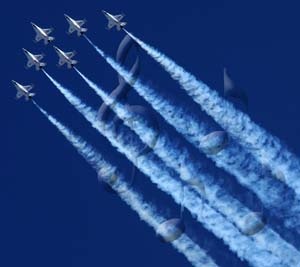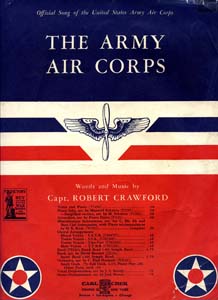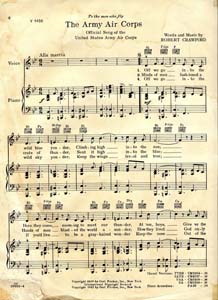In the 1930s, the leadership of the United States Army Air Corps wanted an official service song—one that would inspire, build camaraderie, and forge an identity. The other armed forces had songs: “The Marines’ Hymn,” “Anchors Aweigh,” and “The Army Goes Rolling Along” (originally “The Caisson Song”).
The Air Corps had no budget of its own for such pursuits. Regardless, then-Brig. Gen. Henry H. “Hap” Arnold and his boss, Maj. Gen. Oscar Westover, sought a song to capture the distinctive identity of airmen. They found support in the form of a patriotic publisher and aviation enthusiast named Bernarr A. Macfadden.
In the April 1938 issue of his popular magazine Liberty, Macfadden announced a song contest and put up prize money in the amount of $1,000. Rules stipulated that “harmonic construction must be simple,” while the range “must be within limits of untrained voice” and the pace “in march tempo of military pattern.”
Beyond that, anything was fair game.
 |
|
A deluge of entries came from all parts of the country, written by a cross section of hopefuls that included mechanics, waitresses, bureaucrats, church organists, widows, prison inmates, retirees, and even a few professional composers.
Results fell short of hopes.
Members of the song selection committee pulled no punches in reporting that, after months of judging material, they had found little of value in the 700-plus entries. Most songs fit the rules of simple harmonic construction and vocal limits of untrained voices, more or less, but a progress update from a junior officer-liaison to Arnold noted, “Many of the songs were submitted by persons of unquestioned patriotism, but with obvious signs of illiteracy.”
In newspapers of April 1939, journalists were equally blunt about the songsmiths: “Most of them aped old tunes; none of them caught the spirit of the Air Corps.”
The judging committee, formally known as the Advisory Song Committee or Ladies’ Song Committee, was mostly composed of wives of high-ranking Air Corps officers. Several of their surnames are still familiar—MacDill, Tinker, and Spaatz. Members all had musical credentials and in some cases accomplished backgrounds. This was particularly true of chairwoman Mildred A. Yount, who had been a child musical prodigy before becoming the wife of the Air Corps’ top training commander, Brig. Gen. Barton K. Yount.
The committee “received over 700 manuscripts and only a few were worth even taking to musical experts that we had decided to consult,” groused Mrs. Yount. “The entries were so poor that we sent an appeal to the [American Society of Composers, Authors, and Publishers], calling their attention to the competition, and asking them to enter.”
Commercial music publishers submitted previously published songs, among them “Flying High,” “Aces Up,” and “Men With Wings” (from a movie of the same name). “Wings on High” was the product of Meredith Willson, who went on to musical immortality with “The Music Man.” The Air Corps approached the legendary Irving Berlin to write a song. Although not chosen, it did find fame as the title song in Moss Hart’s play and movie called “Winged Victory.”
The committee’s ultimate charge was to recommend four or five finalists to the Air Corps’ top brass by a deadline that was extended to July 15, 1939.
The song that went on to Air Force immortality wouldn’t arrive until two days before the extended contest deadline.
But what if the song about “the wild blue yonder” hadn’t come in time? Would there have been a choice from the discard pile instead
By some accounts, the rejects could never be known, because Liberty had gone to great lengths to ensure all entries were returned. The magazine’s records of the contest, along with Liberty itself (which folded in 1950) have long disappeared.
Calls to descendants of the song selection committee yielded clippings and pleasant reminiscences, but no contest-related notes. Music historians doubted any traces of the other songs would be found.
Nonetheless, the search eventually led to a dusty box at the National Archives, carted out by an archivist who conjectured that it had not been off the shelf in decades. Inside, jumbled papers revealed bits and pieces of songs, their titles sometimes introduced in yellowed cover letters infused with now-moot enthusiasm.
Today, the Singing Sergeants—official chorus of the Air Force—might be belting out a rendition of “Crank ’er Up,” written by a former airplane mechanic from Washington, D.C. Or perhaps “Eyes of the World Are We.” Or even a scrappy “Give ’er the Gun.”
There was the simple gusto of “Give Me a Ship and a Song.” A bit awkward, but still on course was “Headin’ in the Wind, To Win.”
Some composers fueled patriotism with songs such as “Eagles of Uncle Sam” and “Serve Your Country,” although the latter undoubtedly lost points for lack of Air Corps focus in Marine-like lyrics that included “Uncle Sam trains men for air, on land or sea.”
“Eyes of Our Nation” sounded promising, but began to sputter and stall with a second verse that went as follows:
We’re the eyes of the nation,
Scouting here and there.
Our sky wagons at home in the clouds,
With us none do compare.
We’re the boys of courage,
A stout and fearless bunch.
Let’s sing a song in the choppy air waves
As we do our stunts.
“Squadrons of the Air” made sure we knew we weren’t singing about squadrons of, say, PT boats. One contented composer came up with, “The Air Corps Is Home Sweet Home to Me.”
 |
|
 |
Sheet music for what is now the Air Force’s official song. ( USAF photo by Amn. Jerilyn Quintanilla) |
Too arcane for public consumption was the entry from a retired air officer who offered “The Chandelle,” named for the abrupt turning-while-climbing tactic developed by French pilots in World War I. Another composer set a plodding tempo in “The Airplanes Keep Winging Along,” which could have led smoothly into a medley with other submissions, “Up in the Sky” and “Up in the Stratosphere.”
“Props and Wings” would have grown obsolete quickly after the dawn of the jet age. “Aero Rag” likewise suffered a limited shelf life, especially since ragtime had peaked more than 20 years before.
Certain entries betrayed the real reason some young men become fighter pilots: “All the Girls Smile on Me,” which resonated with other submissions such as “Above the Clouds With You” and “Let’s Take Off Together.”
A few were quite nebulous, such as “Up in the Clouds” and “Over the Clouds.” Several reflected newfound optimism that truly had come with the awe-inspiring advent of airpower: “Peace Forever” and “The Sky Is Clear.”
“Idols of Aviation” and “Come On and Hail the Airmen” appealed to those who worshipped the air heroes of the day.
There were a number of marches, all sounding pretty much the same in name: “United States Air March,” “US Army Air Corps March,” and “The Air Corps on Parade.”
Lyrics of “Air Corps March” were representative of the type:
Hurrah! For the men who man the planes
Through space at ever a dazzlin’ speed
And proudly soar where the eagle reigns
And fill their lives with valiant deeds.
Contact! What a savage thrill it brings
To hearts as they hear the motors roar
And list to the wind and song it brings
And ride the skies like gods of yore.
Hats off! For the men who ride no more
Through time their deeds will live again
And though they rest on that distant shore
Their lives have not been lost in vain.
Chorus
With a whirr and a roar we’ll give ’ er the gun
And fly o’er the highest cloud
With a bank and a turn and a loop well done
Of our mounts we’re justly proud
With a song in our hearts we’ll sing once more
All Glory to the Old Air Corps.
The award for run-on title goes to a composer from Bad Axe, Mich.: “For Greater Than the Eagle’s Wings, Are Air Corps of the USA.” In contrast, “Sons of the Sky” was crisp and alliterated, but too many S-words in its refrain were bound to elicit say-it-don’t-spray-it protests.
Numerous entrants supplied only lyrics, accompanied by hopeful notes asking that a professional composer might kindly tailor a tune to fit. Those could have been married up with the few that came with only the suggestion of a melody, such as “Ninety-Nine Out of a Hundred Wanna Be Loved,” or an idea to create verses to fit the 1867 tune, “The Daring Young Man on the Flying Trapeze,” for which the entrant made a point of claiming in his cover letter that he had witnessed a resurgence in the song’s popularity among young airmen.
A polite query came from a piano tuner in Oregon: In the Corps, was “corps” pronounced singular or plural? It was crucial knowledge to get his rhyming right, he explained. A carbon copy shows then-Lt. Col. Ira C. Eaker, assistant chief of Air Corps public relations, mailed back a dutifully patient response.
Had the committee been forced to finalize their lukewarm choice two days earlier than they did, these would have made the cut: “Give ’er the Gun,” “Wings on High,” “Wings of the Nation,” and “Spirit of the Air Corps.”
The last song, submitted by an Air Corps major, was quietly discouraged from consideration. “Spirit of the Air Corps,” the committee noted, was “an excellent song but, according to our experts, a steal on ‘On Brave Old Army Team.’ “
The group consulted with several professional musicians, including Col. Edmund L. Gruber, composer of “The Caisson Song,” who sagely uttered: “You can’t force Army songs. When you find a song you will like, it will come from a young flyer, one who has the feel of flying in his bones and knows the thrill and the glamour of the Air Corps.”
Gruber, of course, was right: The winning entry came famously at the last moment and in dramatic fashion. As the committee was unenthusiastically wrapping up its work on July 13, Robert M. Crawford was “climbing high into the sun” on a flight to Washington, D.C., to personally deliver a sound recording of his entry. Crawford was a professional musician known as the “Flying Baritone,” because he flew to performances in his own private airplane. He was not a military pilot, but had tried to become one in World War I, only to be washed out of training when he was discovered to be underage. (He would successfully join up early in World War II as a pilot in the US Army Air Forces’ Air Transport Command.)
Crawford had composed his entry days before while flying from New York to his home in Cos Cob, Conn., he told Mrs. Yount. She later recalled him saying the song seemed to come to him “out of the sky into the engine.”
The committee members knew a winner when they heard one. Rudolph Ganz, guest conductor with the National Symphony Orchestra and another professional consulted by the committee, had this reaction, according to Yount’s account: “Ganz himself actually burst from the door and came walking—or rather bounding—down the hall, whistling Mr. Crawford’s song and exclaiming in between measures, ‘It’s a great song. (Whistling.) It has music. (Whistling.) It has fire, spirit. (Whistling.) It will be famous!’ “
Contest rules required a written manuscript, not a sound recording, so Crawford complied with the formality by quickly writing the song in manuscript form. But even Crawford’s winning lyrics and melody came with an ill-advised title as originally submitted: He had named the song, “What Do You Think of the Air Corps Now?”
The song was instead officially given the title “The Army Air Corps.” It was introduced with considerable fanfare at the 1939 National Air Races in Cleveland—sung by the Flying Baritone himself over the public address system and also on national radio.
Not long after the establishment of the US Air Force as a separate and independent service, the song was retitled, “The US Air Force.” Commonly known today by its opening, “Off we go, into the wild blue yonder,” the Air Force song has stood the test of time—but this was a very close call.
David A. Lande is a senior researcher for National Geographic magazine and previously served on the World War II Memorial Staff. This is his first article for Air Force Magazine.